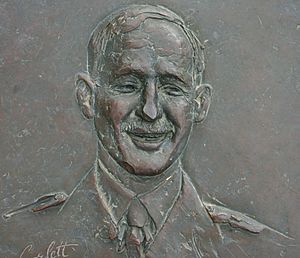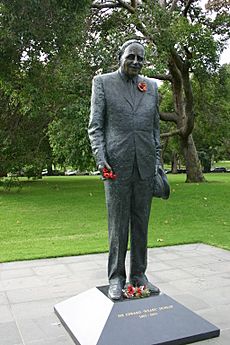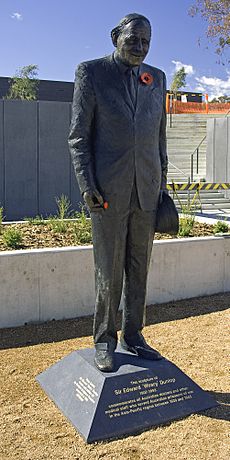Weary Dunlop facts for kids
Quick facts for kids
Sir Edward Dunlop
|
|
|---|---|

Brass relief of Dunlop in uniform
|
|
| Birth name | Ernest Edward Dunlop |
| Nickname(s) | Weary |
| Born | 12 July 1907 Wangaratta, Victoria |
| Died | 2 July 1993 (aged 85) Melbourne, Victoria |
| Allegiance | Australia |
| Service/ |
Australian Army |
| Years of service | 1935–1946 |
| Rank | Colonel |
| Unit | Royal Australian Army Medical Corps 2/2nd Casualty Clearing Station |
| Commands held | No. 1 Allied General Hospital |
| Battles/wars | Second World War |
| Awards | Companion of the Order of Australia Knight Bachelor Companion of the Order of St Michael and St George Officer of the Order of the British Empire Knight of the Venerable Order of Saint John Mentioned in Despatches |
Sir Ernest Edward "Weary" Dunlop (born 12 July 1907, died 2 July 1993) was a famous Australian surgeon. He became well-known for his amazing leadership. This was especially true when he was a prisoner of war during World War II.
Contents
Early Life and Education
Edward Dunlop was born in Wangaratta, Victoria, Australia. He was the second child of James and Alice Dunlop. He went to Benalla High School for two years. After school, he started learning to be a pharmacist.
In 1927, he moved to Melbourne. There, he studied at the Victorian College of Pharmacy and then the University of Melbourne. He earned a scholarship to study medicine. By 1934, Dunlop had graduated from the University of Melbourne. He had top marks in both pharmacy and medicine. He was also a great sportsman at the university. His nickname "Weary" came from his last name, Dunlop, like a "tired" Dunlop tyre.
Rugby Union Career
Even though he grew up playing Australian Rules football, Dunlop also started playing rugby union at university. He began playing for the Melbourne University Rugby Club in 1931. He quickly moved up through the teams. Soon, he was playing for his state and then for Australia. He was the first player born in Victoria to play for the Wallabies.
His first game for Australia was against the All Blacks on 23 July 1932. This game took place at the Sydney Cricket Ground. He played as a number 8.
In 1934, he played for Australia again as a lock. Australia won this game 25–11. Dunlop had broken his nose before this match. It was broken again during the game. He missed the next game due to illness. However, he was part of the first Wallaby team to win the Bledisloe Cup in New Zealand.
In 2008, he was added to the Australian Rugby Union Hall of Fame. He is the only person from Victoria to receive this honour so far.
Pre-War Medical Service


Dunlop had been a school cadet. He continued his part-time army service until 1929. He rejoined the army in 1935. On 1 July, he became a captain in the Australian Army Medical Corps.
In May 1938, Dunlop travelled to London by ship. He worked as the ship's doctor. In London, he studied at St Bartholomew's Medical School. In 1938, he became a Fellow of the Royal College of Surgeons. He met important doctors there who inspired him. He wanted to be as dedicated as they were.
War Service and Imprisonment
During World War II, Dunlop was sent to medical headquarters in the Middle East. There, he helped create a mobile surgical unit. He worked as a surgeon in places like Greece and Tobruk. Later, his troopship was sent to Java to help with defences. On 26 February 1942, he was promoted to temporary lieutenant-colonel.
Dunlop became a Japanese prisoner of war in 1942. He was captured in Bandung, Java, along with the hospital he was leading. Because of his strong leadership, he was put in charge of prisoner-of-war camps in Java. He was later moved to Changi. In January 1943, he led the first group of Australians sent to work on the Burma-Thailand railway. Prisoners were forced to build this important supply route.
Conditions in the railway camps were terrible. There was not enough food. Beatings were common and harsh. There were no medical supplies. Tropical diseases were widespread. The Japanese demanded a lot of work. This was hard even for healthy, well-equipped men.
Dunlop and other doctors showed great courage. They became heroes among the prisoners. He was a brave leader and a caring doctor. He helped prisoners feel hopeful again. He eased the pain of those who were dying. He even stood up to his captors. His example helped more Australians survive than other groups. One of his men called him "a lighthouse of sanity in a universe of madness and suffering."
Life After the War
After 1945, Dunlop put the difficult war years behind him. He chose to forgive his captors. He said, "in suffering we are all equal." He focused his energy on helping and healing. He worked to improve relations between Australia and Asia.
He spent his life helping former prisoners of war and their families. He was involved with many health and education groups. He served on the board of Cancer Council Victoria. He was also the first Australian Patron of St. Andrew's Ambulance Association. His hard work had a big impact on Australians and people in Asia. He received many awards from Australia, Thailand, India, Sri Lanka, and the United Kingdom.
Honours and Awards
'Weary' Dunlop received many honours and awards during his life, including:
- Officer of the Order of the British Empire (1947)
- Companion of the Order of St Michael and St George (1965)
- Knight Bachelor (1969)
- Named Australian of the Year in 1976
- Companion of the Order of Australia (1987)
- Knight Commander of the Order of St John of Jerusalem (1992)
- Knight Grand Cross (1st Class) of the Order of the Crown of Thailand (1993)
- Fellow of the Royal College of Surgeons of England
- Fellow of the Royal Australasian College of Surgeons
- Honorary Fellow of the Imperial College London
- Honorary Fellow of the Royal College of Surgeons of Edinburgh
- Honorary Life Member of the Returned and Services League of Australia
- Life Governor of the Royal Women's Hospital and the Royal Victorian Eye and Ear Hospital.
In 1988, Dunlop was named one of '200 Great Australians'. In 2008, he was added to the Australian Rugby Union Hall of Fame.
After he passed away in 1993, a suburb in Canberra was named Dunlop after him. His picture is on the 1995 Australian fifty-cent coin. The coin says, "They Served Their Country in World War II, 1939 – 1945." A platoon at the Army Recruit Training Centre is also named after him.


